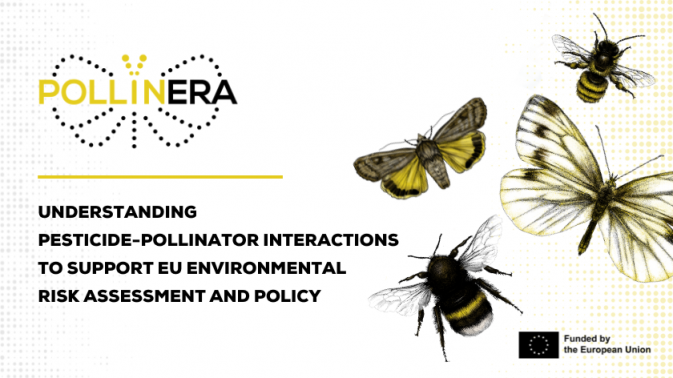Understanding pesticide-pollinator interactions to support EU Environmental Risk Assessment and policy: The PollinERA project

The European Green Deal, the EU biodiversity strategy, the EU zero pollution action plan, and the revised EU pollinators initiative all indicate the need to protect pollinators and address insect and pollinator declines. Plant protection products (PPP), also known as pesticides, have been identified as one of the primary triggers of pollinator decline. However, significant knowledge gaps and critical procedural limitations to current pesticide risk assessment require attention before meaningful improvements can be realised. The functional group is currently represented by only one species, the honey bee, which does not necessarily share other species' biological and ecological traits.
Coordinated by The Social-Ecological Systems Simulation (SESS) Centre, Aarhus University and Prof. Christopher J. Topping, PollinERA (Understanding pesticide-Pollinator interactions to support EU Environmental Risk Assessment and policy) aims to move the evaluation of the risk and impacts of pesticides and suggestions for mitigation beyond the current situation of assessing single pesticides in isolation on honey bees to an ecologically consistent assessment of effects on insect pollinators.
This will be achieved through the development of a new systems-based environmental risk assessment (ERA) scheme, tools and protocols for a broad range of toxicological testing, feeding to in silico models (QSARS, toxicokinetic/toxicodynamic, and ALMaSS agent-based population simulations).
Using a strong stakeholder co-development approach, these models will be combined in a One System framework for risk assessment and policy evaluation including an international long-term monitoring scheme for pollinators and pesticides.
The One System framework builds on the recent roadmap for action on the ERA of chemicals for insect pollinators, developed within the IPol‐ERA project, funded by the European Food Safety Authority (EFSA). The framework will expand the ERA tools currently used for honey bees to include wild bees, butterflies, moths and hoverflies.
With an overall goal of reversing pollinator population declines and reducing the harmful impacts of pesticides, for the next four years, PollinERA will follow four specific objectives:
- Fill ecotoxicological data gaps to enable realistic prediction of the source and routes of exposure and the impact of pesticides on pollinators and their sensitivity to individual pesticides and mixtures.
- Develop and test a co-monitoring scheme for pesticides and pollinators across European cropping systems and landscapes, developing risk indicators and exposure information.
- Develop models for predicting pesticide toxicological effects on pollinators for chemicals and organisms, improve toxicokinetic/toxicodynamic (TKTD) and population models, and predict environment fate.
- Develop a population-level systems-based approach to risk and policy assessment considering multiple stressors and long-term spatiotemporal dynamics at a landscape scale and generate an open database for pollinator/pesticide data and tools.
The PollinERA consortium, represented by 11 partners across eight European countries, comprises a diverse range of scientific disciplines spanning from pollinator ecology, pesticide exposure and toxicological testing, to stakeholder engagement and communications.
Full list of participants:
- Aarhus University
- Jagiellonian University
- Lund University
- University of Bologna
- Osnabrück University
- Institute of Nature Conservation of the Polish Academy of Sciences
- Mario Negri Institute for Pharmacological Research
- BeeLife European Beekeeping Coordination
- Swedish University of Agricultural Sciences
- Pensoft Publishers
- Zip Solutions
Follow us on LinkedIn and X to stay up-to-date with project developments and achievements.